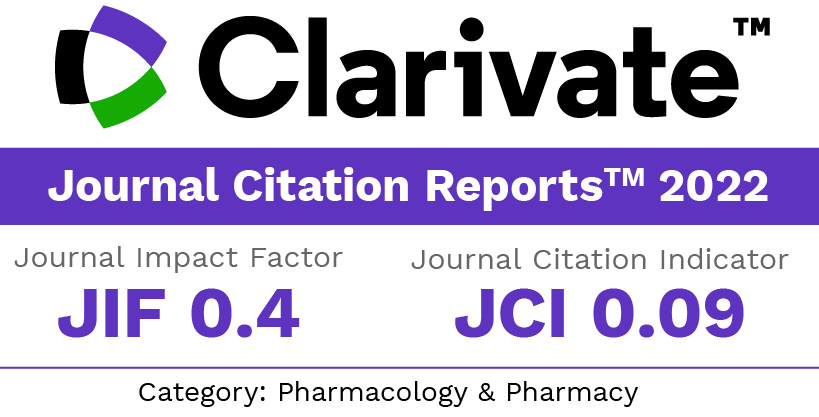Stabilized liquid-crystalline emulsions with triethanolamine stearate and stearic acid: preparation method infl uence in the properties and formation of secondary droplets
Keywords:
Emulsions, Lyotropic liquid crystals, Secondary droplets, Triethanolamine stearateAbstract
It has been developed a methodology which allows obtaining mineral oil emulsions stabilized with triethanolamine stearateand stearic acid with liquid-crystalline characteristics where droplets cluster themselves forming secondary dropletsof 15 μm diameter. The formation of the mentioned secondary droplets, which are a consequence of the presence oflyotropic liquid crystals in the emulsions, produces a diminution of the viscosity. The replacement of part of the mineraloil of these emulsions for others emollients with greater dermal penetration capacity, such as isopropyl myristate and2-octyl-1-dodecanol, does not diminish the liquid-crystalline characteristics, granting the obtainment of more adequateemulsions for pharmaceutical and cosmetic usage.Downloads
References
Suzuki T. Application of lyotropic liquid crystals to cosmetics. Ekisho 1998; 2 (3): 24-31.
Friberg S. Liquid crystalline phases in emulsions. J Colloid Interf Sci 1971; 37 (2): 291-295.
Eccleston GM. Multiple-phase oil-in-water emulsions. J Soc Cosmet Chem 1990; 41: 1-22.
Engels T, Von Rybinski W. Liquid crystalline surfactant phases in chemical applications. Henkel-Referate 1999; 35: 38-46.
Suzuki T, Takei H, Yamazaki S. J Colloid Interf Sci 1989; 129 (2): 491-500.
Rosevear FB. The microscopy of the liquid crystalline neat and middle phases of soaps and synthetic detergents. J Am Oil Chem Soc 1954; 31: 628-639.
Rosevear FB. Liquid crystals: The mesomorphic phases of surfactant compositions. J Soc Cosmet Chem 1968; 19: 581-594.
Pasquali RC, Bregni C, Serrao, R. Identificación de fases líquido cristalinas con el microscopio polarizante. Cosmética, revista de la Asociación Argentina de Químicos Cosméticos 2005; 59: 25-36.
Pasquali RC, Bregni C, Serrao R. Estructura de las principales fases líquido-cristalinas liotrópicas. Acta Farm Bonaerense 2005; 24 (3): 453-457.
Phillips R. Mineral Optics. Principles and Techniques. W. H. Freeman and Company, cap. 5, Estados Unidos; 1971, pp. 75-88.
Verma AR, Reynolds PM. Interferometric Studies of the growth of stearic acid crystals and their optical properties. Proc Phys Soc B 1953; 66: 414-420.
Reynolds PM, Verma AR. Growth and Optical Properties of Stearic Acid Crystals. Nature 1953; 171 (4350): 486-487.
Sato K, Okada M. Growth mechanism of stearic acid single crystals. Journal of Crystal Growth 1977; 42: 264-271.
Beckmann W, Boistelle R. Growth kinetics of the (110) face of stearic acid growing from butanone solutions-pure solutions and in the presence of an emulsifier. Journal of Crystal Growth 1985; 72 (3): 621-630.
CTFA. International Cosmetic Ingredient Dictionary and Handbook. Tenth Edition, versión en CD; 2004.
Kibbe AH. Handbook of pharmaceutical excipients. 3rd edition. American Pharmaceutical Association, Washington; 2000.
Suzuki T, Tsutsumi H, Ishida A. Secondary droplet emulsion: mechanism and effects of liquid crystal formation in o/w emulsion. Journal of Dispersion Science and Technology 1984; 5 (2): 119-141.
Downloads
Published
How to Cite
Issue
Section
License
The articles, which are published in this journal, are subject to the following terms in relation to the rights of patrimonial or exploitation:
- The authors will keep their copyright and guarantee to the journal the right of first publication of their work, which will be distributed with a Creative Commons BY-NC-SA 4.0 license that allows third parties to reuse the work whenever its author, quote the original source and do not make commercial use of it.
b. The authors may adopt other non-exclusive licensing agreements for the distribution of the published version of the work (e.g., deposit it in an institutional telematic file or publish it in a monographic volume) provided that the original source of its publication is indicated.
c. Authors are allowed and advised to disseminate their work through the Internet (e.g. in institutional repositories or on their website) before and during the submission process, which can produce interesting exchanges and increase citations of the published work. (See The effect of open access).


















